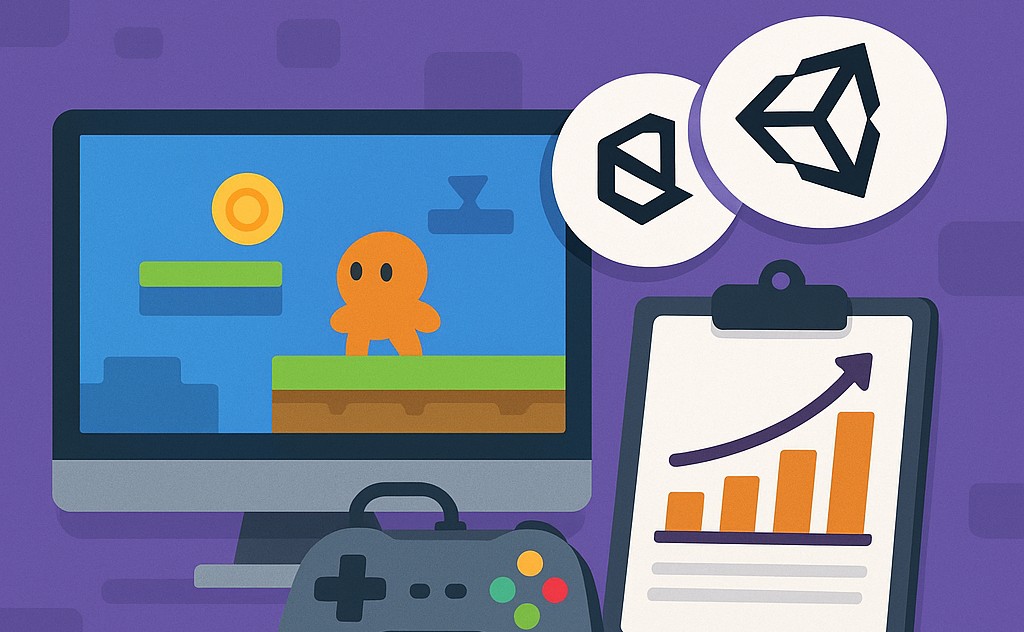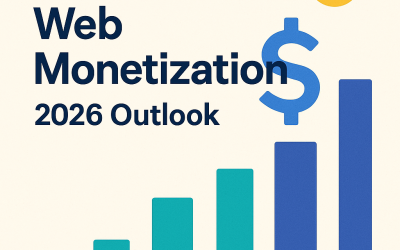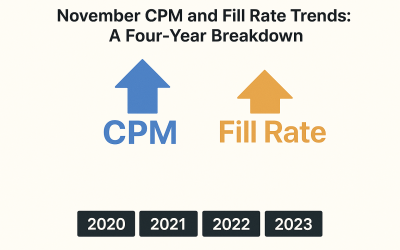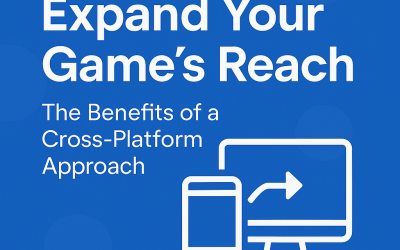Strategies, Tools, and Monetization: WebGL / Unity Games
Browser-based gaming has exploded in popularity over the past few years. WebGL and Unity games now dominate the lightweight gaming market. These games offer instant accessibility without downloads or installations. However, traditional app store monetization models don’t apply here. Developers face unique challenges in generating sustainable revenue from web-based games. Ad-blockers, limited payment integration, and platform restrictions create obstacles. This blog covers actionable strategies for monetizing WebGL and Unity games. We’ll explore proven tools, optimization techniques, and real-world monetization models. Whether you’re launching your first browser game or scaling existing titles, these insights will help maximize your revenue.
Contents
- 1 Why Monetization Matters for WebGL and Unity Games
- 2 Core Monetization Strategies for WebGL / Unity Games
- 3 Tools and SDKs for Monetizing WebGL / Unity Games
- 4 Maximizing Revenue: Key Metrics and Optimization Tips
- 5 Technical Implementation Best Practices
- 6 Common Pitfalls and How to Avoid Them
- 7 AppLixir & WebGL Monetization
Why Monetization Matters for WebGL and Unity Games
Starting with “Strategies, Tools, and Monetization: WebGL / Unity Games” post, Browser games are experiencing unprecedented growth across all demographics. Unity WebGL exports make it easier than ever to deploy games instantly. Players appreciate the convenience of jumping into games without downloads. Yet monetization remains challenging compared to mobile app stores. Traditional in-app purchases often aren’t viable for web games. Ad-blockers reduce potential ad revenue significantly. Platform limitations restrict payment processing options.
These constraints make ad-based monetization essential for web game developers. Rewarded video ads have emerged as the most effective solution. They provide value to players while generating consistent revenue. Alternative strategies like offerwalls and sponsorships complement ad-based approaches. Smart developers combine multiple monetization streams to maximize earnings potential. The key is implementing user-friendly systems that enhance rather than disrupt gameplay.
Core Monetization Strategies for WebGL / Unity Games
Rewarded Video Ads
Rewarded video ads let players opt-in to watch advertisements for in-game benefits. Players receive coins, power-ups, or extra lives after viewing complete ads. This creates a win-win scenario for developers and players. High completion rates make rewarded ads extremely effective for retention. Players feel they’re making a fair trade rather than being interrupted. The voluntary nature reduces negative sentiment toward advertising.
Offerwalls
Offerwalls present players with optional tasks in exchange for premium currency. Tasks might include downloading apps, completing surveys, or signing up for services. This works particularly well for idle games and longer-session titles. Players can progress faster by completing offers while developers earn commission. The key is presenting offerwalls as optional shortcuts rather than paywalls.
Sponsorships / Brand Placement
Direct partnerships with brands can provide substantial revenue without ads. Sponsored levels, branded characters, or product placements work naturally in many games. This approach requires higher player counts but offers better revenue per user.
Microtransactions (when applicable)
While challenging for pure WebGL games, hybrid approaches are emerging. Wallet plugins and payment gateways enable some microtransaction functionality. This works best when combined with other monetization methods.
Tools and SDKs for Monetizing WebGL / Unity Games
AppLixir
Following on our Strategies, Tools, and Monetization: WebGL / Unity Games post, AppLixir specializes in web-based rewarded video advertising for HTML5 games. The platform offers lightweight integration that doesn’t impact game performance. Their non-intrusive approach maintains positive user experience while maximizing revenue. AppLixir provides detailed analytics dashboards for tracking performance metrics. Their SDK supports multiple programming languages including JavaScript and Unity C#. The platform offers competitive revenue splits and fast payment processing.
Unity Ads (for Unity WebGL Builds)
Unity’s native advertising solution integrates seamlessly with Unity WebGL builds. It supports both rewarded video ads and traditional banner formats. The platform offers competitive CPM rates and reliable fill rates. Unity Ads benefits from deep engine integration and optimized performance. The mediation system automatically selects highest-paying ad networks. Cross-promotion tools help developers market their other games effectively.
Google AdMob (with limitations)
While primarily designed for mobile apps, AdMob can work with web games. Integration requires workarounds and custom implementations. Revenue potential is high but technical complexity increases significantly. AdMob’s massive advertiser base ensures strong fill rates globally. The platform offers advanced targeting options and machine learning optimization. However, web integration requires custom JavaScript bridges and careful implementation.
AdinPlay / GameDistribution (HTML5 Focused)
These platforms focus specifically on browser-based games and HTML5 content. They offer simple integration processes and revenue-sharing models. Fill rates are optimized for web traffic patterns. GameDistribution also provides game distribution services alongside monetization tools. AdinPlay specializes in contextual advertising that matches game themes. Both platforms understand web gaming audiences better than mobile-first solutions.
Maximizing Revenue: Key Metrics and Optimization Tips
Track essential metrics to optimize your monetization strategy effectively. eCPM (effective cost per mille) measures revenue per thousand impressions. ARPDAU (average revenue per daily active user) indicates per-user profitability. Monitor ad completion rates to gauge user engagement with your ads. Higher completion rates suggest well-integrated advertising that doesn’t disrupt gameplay. LTV (lifetime value) helps predict long-term revenue potential per user.
A/B Testing Strategies
Following on our Strategies, Tools, and Monetization: WebGL / Unity Games post, A/B testing is crucial for optimization success across all monetization elements. Test different reward values, ad frequencies, and placement timing. Small changes can significantly impact both revenue and user retention. Test reward value scaling against player progression curves. Higher-level players may require more substantial rewards to maintain engagement. Balance generous rewards with sustainable game economy mechanics. Experiment with ad frequency capping to find optimal viewing limits. Too many ads can harm user experience while too few reduce revenue potential. Dynamic frequency adjustment based on player behavior works best.
Revenue Optimization Techniques
Ad revenue calculators help project earnings based on traffic and engagement. Use these tools to set realistic revenue goals and plan development budgets. Remember that mobile WebGL traffic often generates higher eCPMs than desktop.
Seasonal Optimization: Ad rates fluctuate significantly throughout the year. December typically shows highest eCPMs while summer months may see declines. Plan content updates and marketing campaigns around these patterns.
Geographic Targeting: Different regions show varying monetization potential. Tier 1 countries (US, UK, Germany) generate higher ad revenues. Consider localizing content and adjusting strategies for different markets.
Time-of-Day Optimization: Ad performance varies by hour and day of week. Business hours in target markets often show better engagement rates. Schedule ad inventory and adjust frequency based on these patterns.
Optimize ad placement timing to maximize both revenue and user experience. Avoid interrupting critical gameplay moments or challenging sections. Natural break points work best for maintaining positive user sentiment.
Technical Implementation Best Practices
SDK Integration Fundamentals
Proper SDK integration forms the foundation of successful monetization. Load advertising SDKs asynchronously to prevent blocking game initialization. Implement timeout handling for slow network conditions or failed ad requests. Cache ad content whenever possible to reduce loading delays during gameplay. Pre-load rewarded video ads during natural gameplay pauses. This ensures smooth user experience when players choose to watch ads.
Performance Optimization
Web games must balance monetization features with optimal performance. Heavy advertising SDKs can significantly impact loading times and frame rates. Choose lightweight solutions that minimize memory footprint and CPU usage. Implement lazy loading for non-critical monetization components. Load offerwall content only when players access those features. This reduces initial game loading time and improves user experience. Monitor WebGL memory usage carefully when integrating advertising solutions. Some SDKs may cause memory leaks or excessive garbage collection. Regular testing across different devices helps identify performance issues early.
Cross-Platform Considerations
Unity WebGL builds require special attention to browser compatibility. Test advertising integrations across Chrome, Firefox, Safari, and Edge browsers. Mobile browser performance may differ significantly from desktop versions. Consider responsive design principles for ad placement and UI elements. Mobile WebGL games need touch-friendly interfaces for monetization features. Desktop versions may benefit from mouse-over interactions and larger clickable areas.
Security and Privacy Compliance
Implement GDPR and CCPA compliance measures for European and California users. Display clear privacy notices and obtain consent for advertising tracking. Many advertising SDKs provide built-in compliance tools. Validate all ad content and external links to prevent malicious advertising. Some ad networks have less stringent content policies than others. Implement content filtering where possible to maintain brand safety.
Common Pitfalls and How to Avoid Them
Over-Aggressive Monetization
Many developers make the mistake of prioritizing short-term revenue over player experience. Forcing too many ads or making progression impossible without spending drives players away. The most successful games treat monetization as value exchange rather than extraction.
Implement soft paywalls instead of hard blocks to progression. Players should always have free paths to advance, even if slower. This approach builds trust and increases long-term engagement with monetization features.
Ignoring Ad-Blocker Users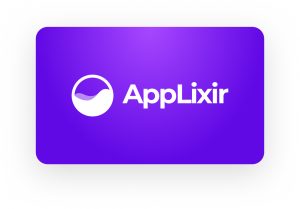
Approximately 25-30% of web users employ ad-blocking software. Ignoring this audience means missing significant revenue opportunities. Implement polite messaging asking users to allow your game site. Consider alternative monetization for ad-blocker users such as optional premium features or cosmetic upgrades. Don’t punish these users with broken gameplay or aggressive messaging about disabled ads.
Poor Ad Integration Timing
Interrupting players during intense gameplay moments creates negative associations with advertising. Time ad opportunities around natural break points like level completion or death screens. Avoid showing ads immediately after game launch before players become engaged. Let users play for several minutes and achieve some success before introducing monetization options.
Neglecting International Markets
Many developers focus only on English-speaking markets and miss global opportunities. Localize monetization messaging and consider regional payment preferences. Some markets prefer different ad formats or reward types. Research local advertising rates and adjust strategies accordingly. Emerging markets may have lower eCPMs but higher engagement rates with certain monetization methods.
Future Trends in Web Game Monetization
Blockchain and NFT Integration
Emerging blockchain technologies offer new monetization possibilities for web games. Players can truly own in-game assets and trade them across platforms. However, implementation complexity and market volatility require careful consideration. Smart contracts enable automated revenue sharing and royalties on asset trades. This creates ongoing revenue streams beyond traditional advertising models. Environmental concerns and technical barriers remain significant challenges.
Progressive Web Apps (PWAs)
PWA technology bridges the gap between web and mobile app experiences. These apps can access device features and work offline like native applications. Monetization opportunities expand with enhanced capabilities and app store distribution. Push notifications enable re-engagement campaigns similar to mobile apps. Local storage improvements allow for more sophisticated monetization tracking and personalization features.
AI-Powered Optimization
Machine learning algorithms increasingly optimize ad placement and reward values automatically. These systems adapt to individual player behavior patterns for maximum engagement and revenue. Predictive analytics help identify players likely to engage with different monetization methods. This enables personalized approaches that improve both user experience and revenue generation.
Cross-Platform Integration
Cloud save systems allow players to continue progress across devices. This creates opportunities for cross-platform monetization where purchases or ad engagement on one device benefits gameplay on others. Unified player profiles enable sophisticated lifetime value calculations and targeted monetization strategies. Players invested across multiple platforms show higher retention and spending rates.
AppLixir & WebGL Monetization
Build monetization considerations into your game design from the beginning. Retrofitting monetization into completed games often creates poor user experiences. Natural integration points should feel like intended game features. Develop relationships with multiple monetization partners to reduce dependency risks. Platform policies and market conditions change frequently. Consider starting with proven platforms like AppLixir before expanding to additional networks.
AppLixir’s developer-friendly approach and competitive revenue sharing make it an ideal foundation for scaling monetization efforts. Their analytics tools help optimize performance before adding complexity with multiple ad networks. Focus on providing genuine value to players through your monetization systems. When done right, ads and offers enhance rather than detract from the gaming experience. Players should feel rewarded for their attention and engagement.
Consider monetization as a core game system requiring the same attention as graphics or gameplay mechanics. Successful web games balance entertainment value with sustainable business models. This approach creates better games and higher long-term revenues.
